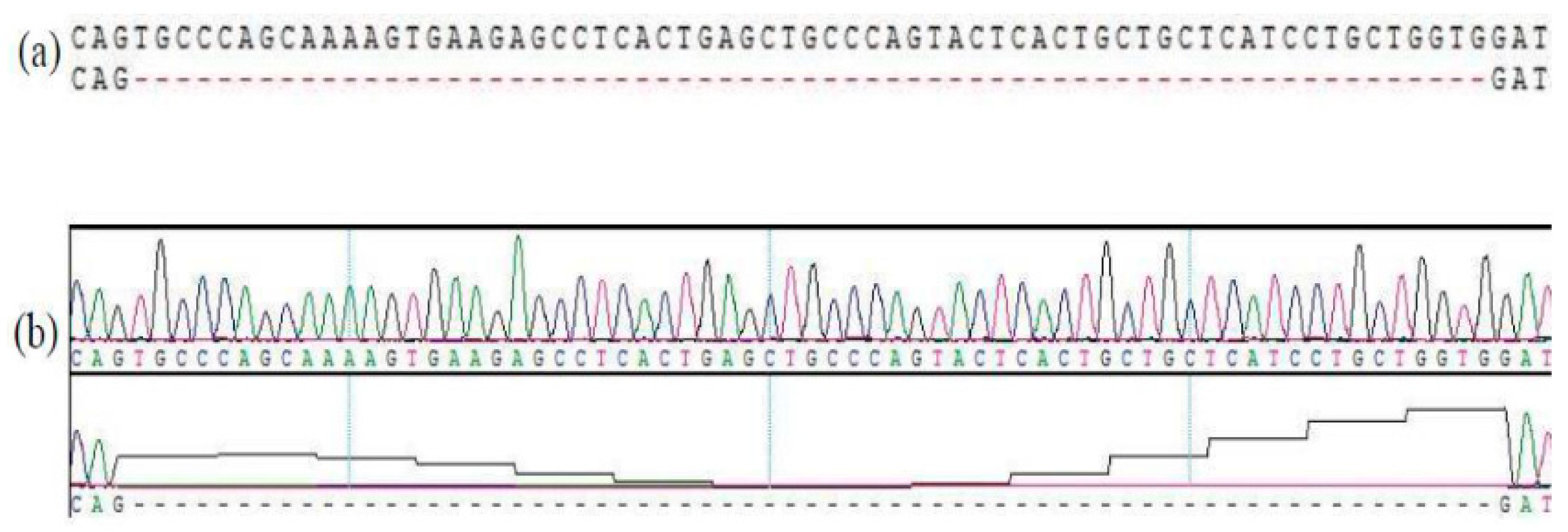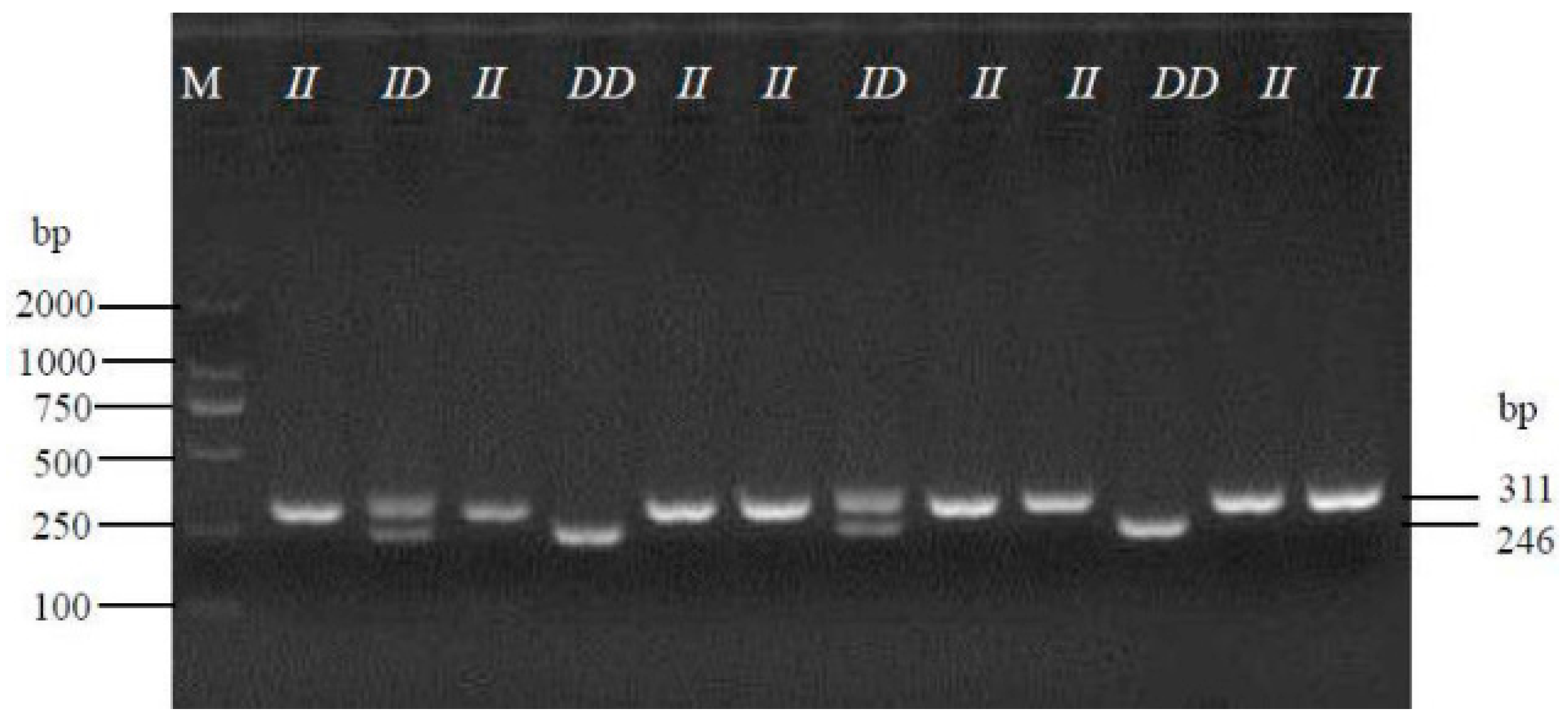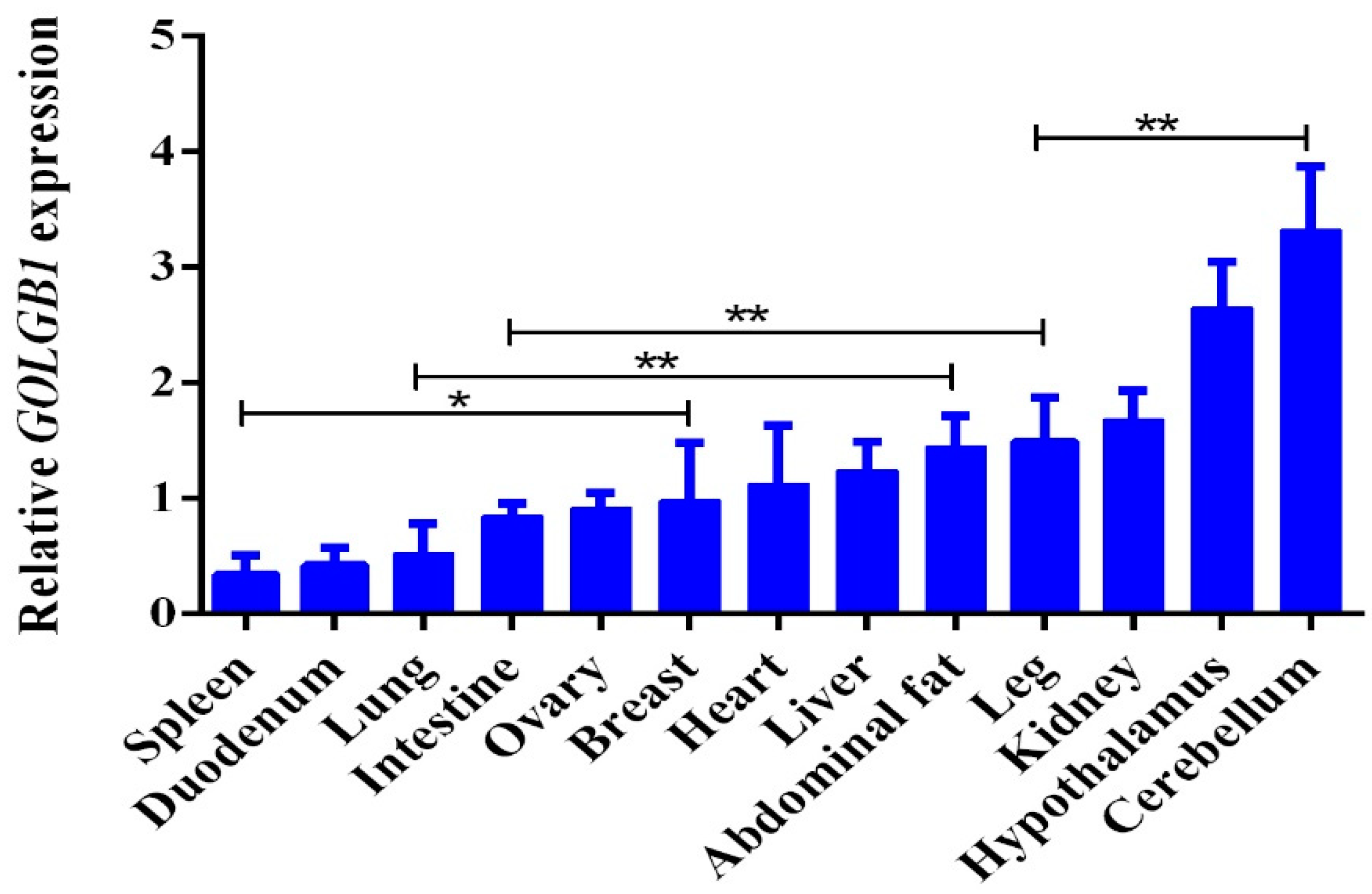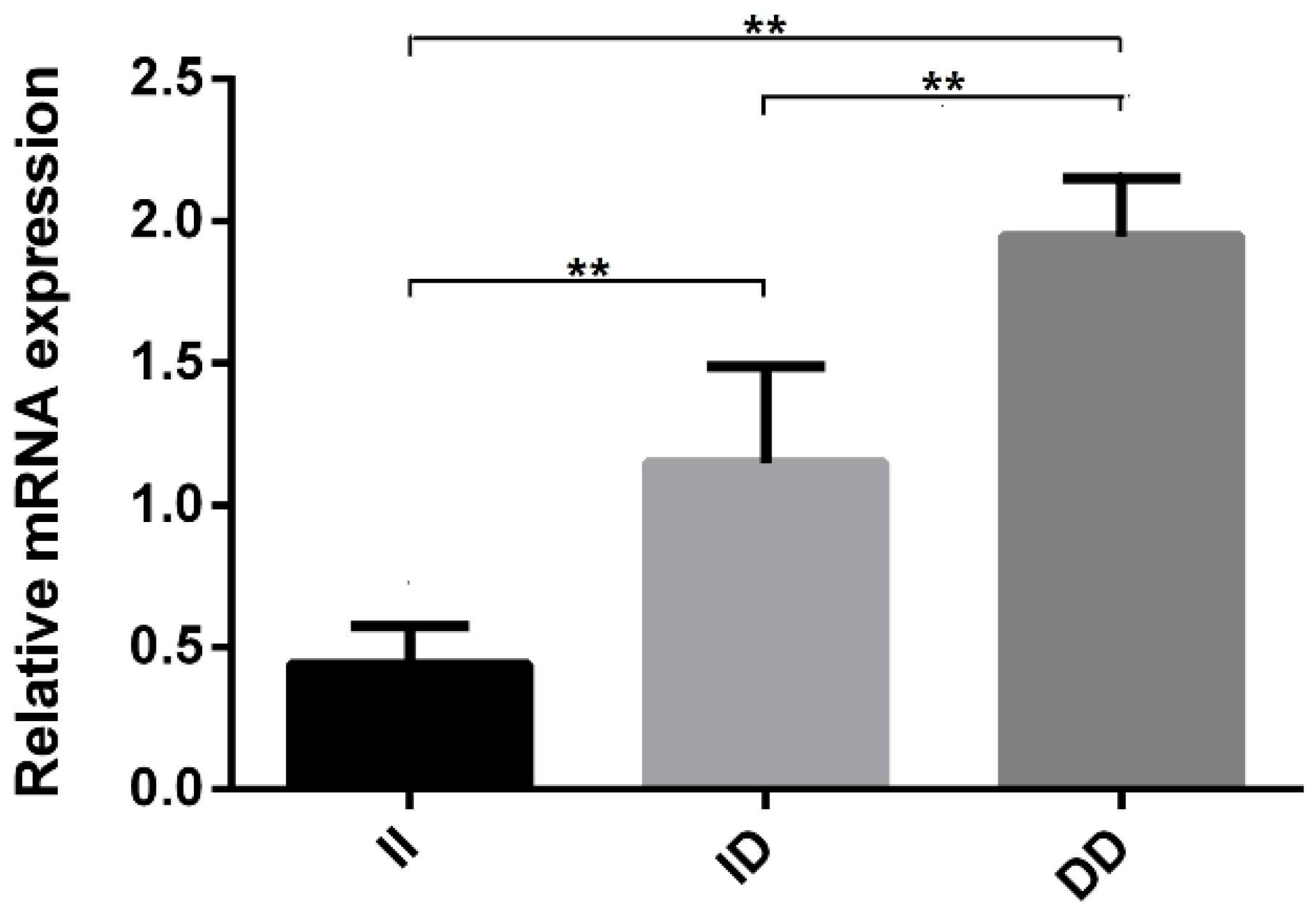A Novel 65-bp Indel in the GOLGB1 Gene Is Associated with Chicken Growth and Carcass Traits
Abstract
Simple Summary
Abstract
1. Introduction
2. Materials and Methods
2.1. Animal Samples and Genomic DNA Collection
2.2. Genetic Variation and Genotyping
2.3. RNA Isolation and cDNA Synthesis
2.4. Real-Time Quantitative PCR Analysis
2.5. Statistical Analysis
3. Results
3.1. Identification of a Novel GOLGB1 65-bp Indel Polymorphism
3.2. Genetic Diversity of the 65-bp Indel in the Eight Different Chinese Local Chickens
3.3. Association of the 65-bp Indel with Chicken Growth Traits
3.4. The Expression Profiles of the Chicken GOLGB1 Gene
3.5. Significantly Differential Gene Expression of the Three Genotypes
4. Discussion
5. Conclusions
Author Contributions
Funding
Acknowledgments
Conflicts of Interest
References
- Linstedt, A.D.; Hauri, H.P. Giantin, a novel conserved Golgi membrane protein containing a cytoplasmic domain of at least 350 kDa. Mol. Boil. Cell 1993, 4, 679–693. [Google Scholar] [CrossRef] [PubMed]
- Smits, P.; Bolton, A.D.; Funari, V.; Hong, M.; Boyden, E.D.; Lu, L.; Manning, D.K.; Dwyer, N.D.; Moran, J.; Prysak, M.; et al. Lethal skeletal dysplasia in mice and humans lacking the golgin GMAP-210. N. Engl. J. Med. 2010, 362, 206–216. [Google Scholar] [CrossRef] [PubMed]
- Freeze, H.H.; Ng, B.G. Golgi Glycosylation and Human Inherited Diseases. Cold Spring Harb. Perspect. Boil. 2011, 3, a005371. [Google Scholar] [CrossRef] [PubMed]
- Lan, Y.; Zhang, N.; Liu, H.; Xu, J.; Jiang, R. Golgb1 regulates protein glycosylation and is crucial for mammalian palate development. Development 2016, 143, 2344–2355. [Google Scholar] [CrossRef] [PubMed]
- Johansen, J.S.; Olee, T.; Price, P.A.; Hashimoto, S.; Ochs, R.L.; Lotz, M. Regulation of YKL-40 production by human articular chondrocytes. Arthritis Rheum. 2001, 44, 826–837. [Google Scholar] [CrossRef]
- Kentaro, K.; Tetsu, S.; Syo, G.; Kei, O.; Hiromi, M.; Katsushi, S.; Hiroetsu, S. Insertional mutation in the Golgb1 gene is associated with osteochondrodysplasia and systemic edema in the OCD rat. Bone 2011, 49, 1027–1036. [Google Scholar]
- Liu, W.; Ge, S.; Liu, Y.; Wei, C.; Ding, Y.; Chen, A.; Wu, Q.; Zhang, Y. Polymorphisms in three genes are associated with hemorrhagic stroke. Brain Behav. 2015, 5, 00395. [Google Scholar] [CrossRef]
- Flanagan, J.M.; Sheehan, V.; Linder, H.; Howard, T.A.; Wang, Y.-D.; Hoppe, C.C.; Aygun, B.; Adams, R.J.; Neale, G.A.; Ware, R.E. Genetic mapping and exome sequencing identify 2 mutations associated with stroke protection in pediatric patients with sickle cell anemia. Blood 2013, 121, 3237–3245. [Google Scholar] [CrossRef]
- Mills, R.E.; Luttig, C.T.; Larkins, C.E.; Beauchamp, A.; Tsui, C.; Pittard, W.S.; Devine, S.E. An initial map of insertion and deletion (INDEL) variation in the human genome. Genome Res. 2006, 16, 1182–1190. [Google Scholar] [CrossRef]
- Rao, Y.S.; Wang, Z.F.; Chai, X.W.; Wu, G.Z.; Nie, Q.H.; Zhang, X.Q. Indel segregating within introns in the chicken genome are positively correlated with the recombination rates. Hereditas 2010, 147, 53–57. [Google Scholar] [CrossRef] [PubMed]
- Yan, Y.; Yi, G.; Sun, C.; Qu, L.; Yang, N. Genome-Wide Characterization of Insertion and Deletion Variation in Chicken Using Next Generation Sequencing. PLoS ONE 2014, 9, e104652. [Google Scholar] [CrossRef] [PubMed]
- Yang, S.; Shi, Z.; Ou, X.; Liu, G. Whole-genome resequencing reveals genetic indels of feathered-leg traits in domestic chickens. J. Genet. 2019, 98, 47. [Google Scholar] [CrossRef] [PubMed]
- Boschiero, C.; Gheyas, A.A.; Ralph, H.; Eory, L.; Paton, I.R.; Kuo, R.I.; Fulton, J.E.; Preisinger, R.; Kaiser, P.; Burt, D. Detection and characterization of small insertion and deletion genetic variants in modern layer chicken genomes. BMC Genom. 2015, 16, 562. [Google Scholar] [CrossRef] [PubMed][Green Version]
- Wang, X.; Li, Z.; Guo, Y.; Wang, Y.; Sun, G.; Jiang, R.; Kang, X.; Han, R.-L. Identification of a novel 43-bp insertion in the heparan sulfate 6-O-sulfotransferase 3 (HS6ST3) gene and its associations with growth and carcass traits in chickens. Anim. Biotechnol. 2018, 30, 1–8. [Google Scholar] [CrossRef] [PubMed]
- Wang, K.; Cui, Y.; Wang, Z.; Yan, H.; Meng, Z.; Zhu, H.; Qu, L.; Lan, X.; Pan, C. One 16-bp insertion/deletion (indel) within the KDM6A gene revealing strong associations with growth traits in goat. Gene 2019, 686, 16–20. [Google Scholar] [CrossRef] [PubMed]
- Xu, Y.; Shi, T.; Zhou, Y.; Liu, M.; Klaus, S.; Lan, X.; Lei, C.; Chen, H. A novel PAX7 10-bp indel variant modulates promoter activity, gene expression and contributes to different phenotypes of Chinese cattle. Sci. Rep. 2018, 8, 1724. [Google Scholar] [CrossRef]
- Kerje, S.; Sharma, P.; Gunnarsson, U.; Kim, H.; Bagchi, S.; Fredriksson, R.; Schütz, K.; Jensen, P.; Von Heijne, G.; Okimoto, R.; et al. The Dominant white, Dun and Smoky Color Variants in Chicken Are Associated With Insertion/Deletion Polymorphisms in the PMEL17 Gene. Genetics 2004, 168, 1507–1518. [Google Scholar] [CrossRef]
- Cui, J.-X.; Du, H.-L.; Liang, Y.; Deng, X.-M.; Li, N.; Zhang, X. Association of Polymorphisms in the Promoter Region of Chicken Prolactin with Egg Production. Poult. Sci. 2006, 85, 26–31. [Google Scholar] [CrossRef]
- Fang, M.; Nie, Q.; Luo, C.; Zhang, D.; Zhang, X. An 8bp indel in exon 1 of Ghrelin gene associated with chicken growth. Domest. Anim. Endocrinol. 2007, 32, 216–225. [Google Scholar] [CrossRef]
- Zhang, S.; Han, R.; Gao, Z.; Zhu, S.; Tian, Y.; Sun, G.; Kang, X. A novel 31-bp indel in the paired box 7 (PAX7) gene is associated with chicken performance traits. Br. Poult. Sci. 2014, 55, 31–36. [Google Scholar] [CrossRef]
- Li, W.; Liu, D.; Tang, S.; Li, D.; Han, R.-L.; Tian, Y.-D.; Li, H.; Li, G.; Li, W.; Liu, X.; et al. A multiallelic indel in the promoter region of the Cyclin-dependent kinase inhibitor 3 gene is significantly associated with body weight and carcass traits in chickens. Poult. Sci. 2019, 98, 556–565. [Google Scholar] [CrossRef] [PubMed]
- Liang, K.; Wang, X.; Tian, X.; Geng, R.; Li, W.; Jing, Z.; Han, R.; Tian, Y.; Liu, X.; Kang, X.; et al. Molecular characterization and an 80-bp indel polymorphism within the prolactin receptor (PRLR) gene and its associations with chicken growth and carcass traits. 3 Biotech 2019, 9, 296. [Google Scholar] [CrossRef] [PubMed]
- Liu, D.; Han, R.; Wang, X.; Li, W.; Tang, S.; Wang, Y.; Jiang, R.; Yan, F.; Wang, C.; Liu, X.; et al. A novel 86-bp indel of the motilin receptor gene is significantly associated with growth and carcass traits in Gushi-Anka F2 reciprocal cross chickens. Br. Poult. Sci. 2019, 60, 649–658. [Google Scholar] [CrossRef] [PubMed]
- Ren, T.; Li, W.; Liu, D.; Liang, K.; Wang, X.; Li, H.; Jiang, R.; Tian, Y.; Kang, X.; Li, Z. Two insertion/deletion variants in the promoter region of the QPCTL gene are significantly associated with body weight and carcass traits in chickens. Anim. Genet. 2019, 50, 279–282. [Google Scholar] [CrossRef] [PubMed]
- Tang, S.; Ou, J.; Sun, D.; Xu, G.; Zhang, Y. A novel 62-bp indel mutation in the promoter region of transforming growth factor-beta 2 (TGFB2) gene is associated with body weight in chickens. Anim. Genet. 2011, 42, 108–112. [Google Scholar] [CrossRef] [PubMed]
- Xie, L.; Luo, C.; Zhang, C.; Zhang, R.; Tang, J.; Nie, Q.; Ma, L.; Hu, X.; Li, N.; Da, Y.; et al. Genome-Wide Association Study Identified a Narrow Chromosome 1 Region Associated with Chicken Growth Traits. PLoS ONE 2012, 7, e30910. [Google Scholar] [CrossRef]
- Lang, Q.Q. Study on the Selection Method of High Quality Chicken Belly Fat Rate. Master’s Thesis, South China Agricultural University, Guangzhou, China, 2018. [Google Scholar]
- Yong, Y.; He, L. SHEsis, a powerful software platform for analyses of linkage disequilibrium, haplotype construction, and genetic association at polymorphism loci. Cell Res. 2005, 15, 97–98. [Google Scholar] [CrossRef]
- Nei, M.; Roychoudhury, A.K. Sampling Variances of Heterozygosity and Genetic Distance. Genetics 1974, 76, 379–390. [Google Scholar]
- Chen, X.; Ouyang, H.; Chen, B.; Li, G.; Wang, Z.; Nie, Q. Genetic effects of the EIF5A2 gene on chicken growth and skeletal muscle development. Livest. Sci. 2019, 225, 62–72. [Google Scholar] [CrossRef]
- Liu, X.; Zhang, H.; Li, H.; Li, N.; Zhang, Y.; Zhang, Q.; Wang, S.; Wang, Q.; Wang, H. Fine-Mapping Quantitative Trait Loci for Body Weight and Abdominal Fat Traits: Effects of Marker Density and Sample Size. Poult. Sci. 2008, 87, 1314–1319. [Google Scholar] [CrossRef]
- Munro, S. The Golgin Coiled-Coil Proteins of the Golgi Apparatus. Cold Spring Harb. Perspect. Boil. 2011, 3, a005256. [Google Scholar] [CrossRef] [PubMed]
- Sapperstein, S.K.; Walter, D.M.; Grosvenor, A.R.; Heuser, J.E.; Waters, M.G. p115 is a general vesicular transport factor related to the yeast endoplasmic reticulum to Golgi transport factor Uso1p. Proc. Natl. Acad. Sci. USA 1995, 92, 522–526. [Google Scholar] [CrossRef] [PubMed]
- Alvarez, C.; Garcia-Mata, R.; Hauri, H.-P.; Sztul, E. The p115-interactive Proteins GM130 and Giantin Participate in Endoplasmic Reticulum-Golgi Traffic. J. Boil. Chem. 2000, 276, 2693–2700. [Google Scholar] [CrossRef] [PubMed]
- Puthenveedu, M.; Linstedt, A.D. Evidence that Golgi structure depends on a p115 activity that is independent of the vesicle tether components giantin and GM130. J. Cell Boil. 2001, 155, 227–238. [Google Scholar] [CrossRef] [PubMed]
- Sönnichsen, B.; Lowe, M.; Levine, T.; Jämsä, E.; Dirac-Svejstrup, B.; Warren, G. A Role for Giantin in Docking COPI Vesicles to Golgi Membranes. J. Cell Boil. 1998, 140, 1013–1021. [Google Scholar] [CrossRef] [PubMed]
- Shaul, O. How introns enhance gene expression. Int. J. Biochem. Cell Boil. 2017, 91, 145–155. [Google Scholar] [CrossRef]
- Chatterjee, S.; Min, L.; Karuturi, R.K.M.; Lufkin, T. The role of post-transcriptional RNA processing and plasmid vector sequences on transient transgene expression in zebrafish. Transgenic Res. 2009, 19, 299–304. [Google Scholar] [CrossRef]
- Pan, Y.-Y.; Chen, R.; Zhu, L.; Wang, H.; Huang, D.-F.; Lang, Z.-H. Utilizing modified ubi1 introns to enhance exogenous gene expression in maize (Zea mays L.) and rice (Oryza sativa L.). J. Integr. Agric. 2016, 15, 1716–1726. [Google Scholar] [CrossRef][Green Version]
- Torre, C.M.D.L.; Finer, J.J. The intron and 5′ distal region of the soybean Gmubi promoter contribute to very high levels of gene expression in transiently and stably transformed tissues. Plant. Cell Rep. 2015, 34, 111–120. [Google Scholar] [CrossRef]
- Wang, D.; Guo, Y.; Wrighton, S.A.; Cooke, G.E.; Sadee, W. Intronic polymorphism in CYP3A4 affects hepatic expression and response to statin drugs. Pharmacogenomics J. 2010, 11, 274–286. [Google Scholar] [CrossRef]
- Cui, Y.; Yan, H.; Wang, K.; Xu, H.; Zhang, X.; Zhu, H.; Liu, J.; Qü, L.; Lan, X.; Pan, C. Insertion/Deletion Within the KDM6A Gene Is Significantly Associated With Litter Size in Goat. Front. Genet. 2018, 9, 91. [Google Scholar] [CrossRef] [PubMed]




| Primer | Sequence (5′–3′) | Product Length (bp) |
|---|---|---|
| P1 | F: TGTGGTAGCTCTCTCCTCCC | 311 |
| R: AGGCTCTCCTGCTGACCATA | ||
| P2 | F: CACTGCGAACCCACGAGA | 157 |
| R: CCCAAACCTGACAAACGGC | ||
| β-actin | F: GACTGACCGCGTTACTCCCA | 166 |
| R: CCAACCATCACACCCTGATGTC |
| Breeds | Genotypic Distribution | Allelic Frequencies | He | Ne | PIC | HWE (p-Value) | ||||
|---|---|---|---|---|---|---|---|---|---|---|
| II | ID | DD | n | I | D | |||||
| WC | 49 | 30 | 9 | 88 | 0.73 | 0.27 | 0.397 | 1.658 | 0.318 | 0.124 |
| SH | 30 | 32 | 10 | 72 | 0.64 | 0.36 | 0.461 | 1.857 | 0.355 | 0.102 |
| GS | 37 | 27 | 5 | 74 | 0.68 | 0.32 | 0.392 | 1.646 | 0.315 | 0.125 |
| XH | 25 | 39 | 7 | 71 | 0.63 | 0.37 | 0.468 | 1.879 | 0.358 | 0.100 |
| QY | 26 | 27 | 7 | 60 | 0.66 | 0.34 | 0.450 | 1.818 | 0.349 | 0.998 |
| LS | 11 | 17 | 10 | 38 | 0.51 | 0.49 | 0.500 | 1.999 | 0.375 | 0.519 |
| MH | 335 | 211 | 32 | 578 | 0.76 | 0.24 | 0.363 | 1.569 | 0.297 | 0.871 |
| N409 | 229 | 138 | 14 | 381 | 0.77 | 0.23 | 0.341 | 1.517 | 0.283 | 0.220 |
| Traits | (Mean ± SE) | p-Value | ||
|---|---|---|---|---|
| II | ID | DD | ||
| Body weight | 1735.16 ± 12.21a | 1705.38 ± 15.56a | 1594.71 ± 49.077b | 0.0121 |
| Neck weight | 117.17 ± 1.19a | 111.80 ± 1.53b | 104.86 ± 4.82b | 0.0026 |
| Abdominal fat weight | 102.35 ± 1.91a | 93.65 ± 2.46b | 77.83 ± 7.74b | 0.0006 |
| Abdominal fat percentage | 5.83 ± 0.089a | 5.42 ± 0.11b | 4.85 ± 0.36b | 0.0015 |
| Yellow index b of breast | 3.78 ± 0.26a | 3.71 ± 0.33a | 7.36 ± 1.05b | 0.0039 |
| Eviscerated weight | 1050.03 ± 7.96 | 1036.66 ± 10.22 | 998.77 ± 32.20 | 0.2188 |
| Subcutaneous fat thickness | 0.76 ± 0.11 | 0.76 ± 0.14 | 0.67 ± 0.44 | 0.1627 |
| Chest width | 7.09 ± 0.27 | 7.10 ± 0.35 | 7.12 ± 1.09 | 0.9565 |
| Back width | 8.62 ± 0.39 | 8.57 ± 0.50 | 8.40 ± 1.56 | 0.3255 |
| Body length | 43.07 ± 0.10 | 42.87 ± 0.13 | 42.71 ± 0.42 | 0.4130 |
| Shank length | 7.76 ± 0.23 | 7.80 ± 0.30 | 7.78 ± 0.94 | 0.6231 |
| Cockscomb height | 2.49 ± 0.35 | 2.38 ± 0.45 | 2.46 ± 1.41 | 0.1935 |
| Yellow index L of abdominal fat | 42.20 ± 0.30 | 43.03 ± 0.39 | 41.75 ± 1.23 | 0.2078 |
| Yellow index L of breast | 57.78 ± 0.36 | 56.92 ± 0.46 | 56.37 ± 1.46 | 0.2671 |
| Yellow index a of breast | 2.73 ± 0.08 | 2.60 ± 0.11 | 2.89 ± 0.34 | 0.5423 |
| Yellow index L of leg | 62.70 ± 0.24 | 62.53 ± 0.31 | 62.20 ± 0.98 | 0.4124 |
| Yellow index a of leg | 13.72 ± 0.19 | 13.64 ± 0.24 | 14.46 ± 0.76 | 0.5917 |
| Yellow index b of leg | 35.22 ± 0.31 | 34.84 ± 0.39 | 36.51 ± 1.23 | 0.3870 |
© 2020 by the authors. Licensee MDPI, Basel, Switzerland. This article is an open access article distributed under the terms and conditions of the Creative Commons Attribution (CC BY) license (http://creativecommons.org/licenses/by/4.0/).
Share and Cite
Fu, R.; Ren, T.; Li, W.; Liang, J.; Mo, G.; Luo, W.; He, D.; Liang, S.; Zhang, X. A Novel 65-bp Indel in the GOLGB1 Gene Is Associated with Chicken Growth and Carcass Traits. Animals 2020, 10, 475. https://doi.org/10.3390/ani10030475
Fu R, Ren T, Li W, Liang J, Mo G, Luo W, He D, Liang S, Zhang X. A Novel 65-bp Indel in the GOLGB1 Gene Is Associated with Chicken Growth and Carcass Traits. Animals. 2020; 10(3):475. https://doi.org/10.3390/ani10030475
Chicago/Turabian StyleFu, Rong, Tuanhui Ren, Wangyu Li, Jiaying Liang, Guodong Mo, Wen Luo, Danlin He, Shaodong Liang, and Xiquan Zhang. 2020. "A Novel 65-bp Indel in the GOLGB1 Gene Is Associated with Chicken Growth and Carcass Traits" Animals 10, no. 3: 475. https://doi.org/10.3390/ani10030475
APA StyleFu, R., Ren, T., Li, W., Liang, J., Mo, G., Luo, W., He, D., Liang, S., & Zhang, X. (2020). A Novel 65-bp Indel in the GOLGB1 Gene Is Associated with Chicken Growth and Carcass Traits. Animals, 10(3), 475. https://doi.org/10.3390/ani10030475





